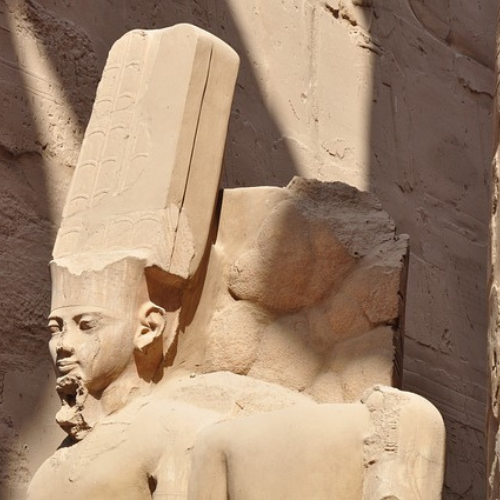Ancient Egyptian artwork and architecture

Ancient Egyptian artwork and architecture
Egyptian artwork and architecture, historical monuments, sculptures, paintings, and implemented crafts were produced especially throughout the dynastic intervals of the primary 3 millennia BCE within the Nile valley areas of Egypt and Nubia. The path of artwork in Egypt paralleled a massive quantity of the country’s political history, however, it depended as properly on the entrenched notion with inside the permanence of the natural,
Divinely ordained order. Artistic fulfillment in each structure and representational artwork geared toward the maintenance of paperwork and conventions that had been held to mirror the perfection of the sector on the primordial second of introduction and to encompass the best courting among humankind, the king, and the pantheon of the gods. For this reason, Egyptian artwork seems outwardly resistant to
improvement and the exercising of personal creative judgment, however, Egyptian artisans of each historic length determined one-of-a-kind answers for the conceptual demanding situations posed to them.
For the functions of definition, “historic Egyptian” is coterminous with pharaonic Egypt, the dynastic shape of Egyptian history, synthetic even though it can in part, supply a handy chronological framework. The one-of-a-kind durations are Predynastic (c. sixth millennium BCE–c. 2925 BCE); Early Dynastic (1st–third dynasties, c. 2925–c. 2575 BCE); Old Kingdom (4th–eighth dynasties, c. 2575–c. 2130 BCE); First Intermediate (9th–eleventh dynasties, c. 2130–1939 BCE); Middle Kingdom (12th–14th dynasties, 1938–c. 1630 BCE); Second Intermediate (15th–seventeenth dynasties, c. 1630–1540 BCE); New Kingdom (18th–twentieth dynasties, 1539–1075 BCE); Third Intermediate (21st–twenty-fifth dynasties, c. 1075–656 BCE); and Late (26th–thirty-first dynasties, 664–332 BCE).
Geographical elements had been fundamental in forming Egyptian art’s unique man or woman. By presenting Egypt with the maximum predictable agricultural gadget in the historic world, the Nile afforded a balance of lifestyles wherein arts and crafts simply flourished. Equally, the deserts and the sea, which included Egypt on all sides, contributed to this balance with the aid of using discouraging critical invasion for nearly 2,000 years. The desolate tract hills had been wealthy in minerals and first-rate stones, equipped to be exploited with the aid of using artists and craftspeople. Only correct timber become lacking, and the want for it led the Egyptians to adopt overseas expeditions to Lebanon, Somalia, and, thru intermediaries, to tropical Africa. In general, the look for beneficial and treasured substances decided the route of overseas coverage and the status quo of exchange routes and led in the end to the enrichment of Egyptian cloth culture. For similar treatment, see Egypt; Middle Eastern religions, historic.
Architecture The important constructing substances utilized in historical Egypt had been unbaked dust brick and stone. From the Old Kingdom onward stone changed into typically used for tombs—the everlasting dwellings of the dead—and temples—the everlasting homes of the gods. Mud brick remained the home material, used even for royal palaces; it changed into extensively utilized for fortresses, the super partitions of temple precincts and cities, and subsidiary homes in temple complexes. Most historical Egyptian cities were misplaced because they had been located inside the cultivated and flooded region of the Nile Valley; many temples and tombs have survived because they had been constructed on a floor unaffected by the aid of using the Nile flood. Any survey of Egyptian structure will in effect be weighted in prefer of funerary and non-secular homes. Yet the dry, warm weather of Egypt has allowed a few dust brick systems to live on in which they have got escaped the detrimental outcomes of water or man.
Tomb structure Mortuary structures in Egypt become pretty advanced and regularly grandiose. The tomb becomes an area wherein a corpse is probably blanketed from desecration and furnished with cloth gadgets to make certain persevered life after death. Part of the tomb is probably adorned with scenes that could permit the character to pursue magically an afterlife appropriate and much like his or her worldly life. For a king the expectancies had been pretty different; for him, the tomb have become the automobile wherein he may obtain his one-of-a-kind future with the gods in a celestial afterlife. Most tombs comprised foremost parts, the burial chamber (the tomb proper) and the chapel, wherein services for the deceased can be made. In royal burials, the chapel hastily advanced right into a mortuary temple, which starts inside the New Kingdom and becomes commonly constructed one at a time and away from the tomb. In the subsequent discussion, funerary temples constructed one at a time may be mentioned with temples in widespread and now no longer as a part of the funerary complex.


You actually make it seem really easy with your presentation however I in finding this topic to be really something which I feel
I would by no means understand. It sort of feels too complex and extremely broad for me.
I’m looking ahead for your next publish, I’ll try to get the hold of it!
Quite right! Idea excellent, it agree with you.